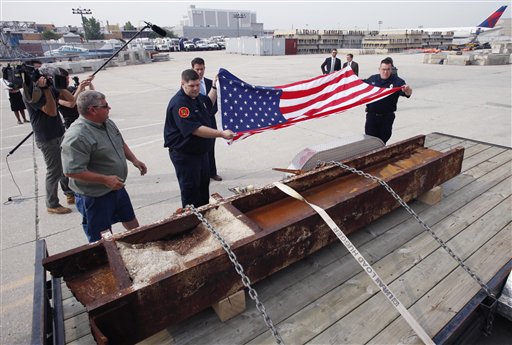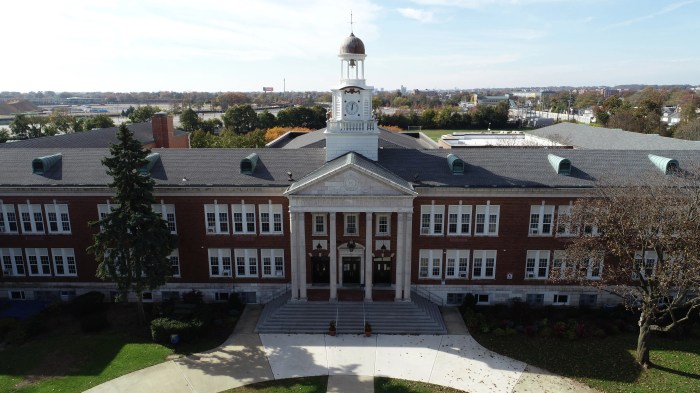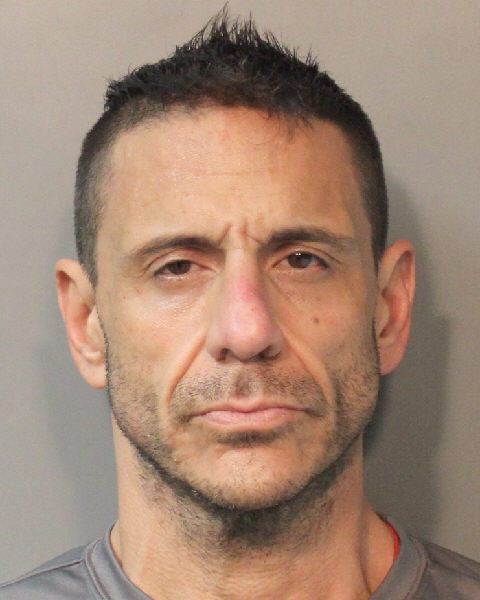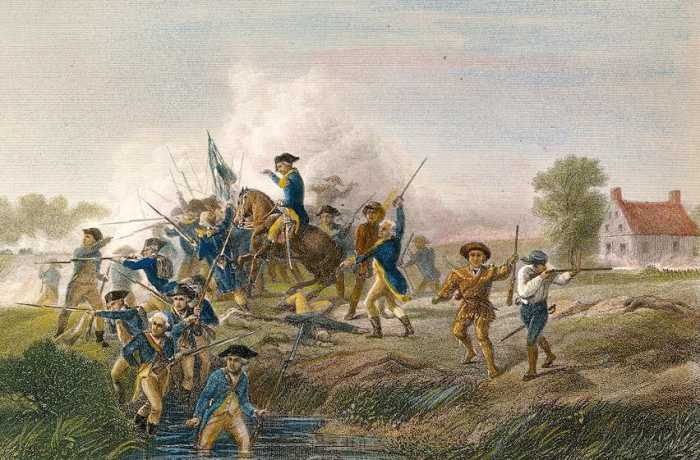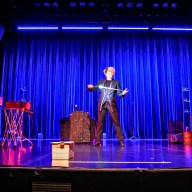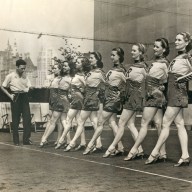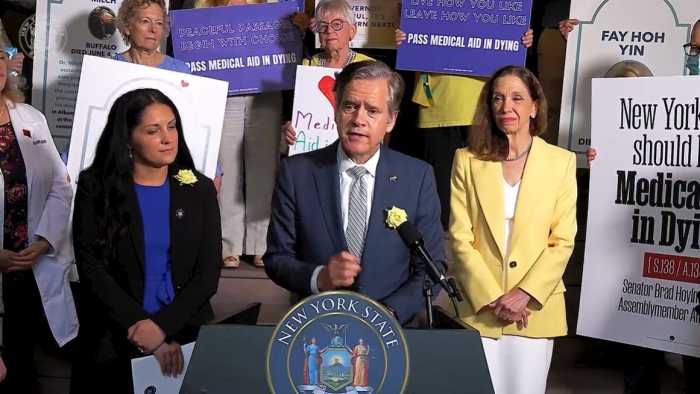
Back home, where Rick Sluder is the police chief of a village of 3,000 surrounded by corn and soybean fields, traffic wouldn’t be an issue. But this morning, at the helm of a rented van mired in New York traffic thicker than the summer heat, he’s way out of his jurisdiction.
Inching up a ramp that dumps into the Cross Bronx Expressway, Sluder’s eyes dart between the road and the rearview mirror, tracking a red pickup that trails close behind, towing precious cargo. It takes a special mission for men to leave families, jobs and the familiarity of northwest Ohio and drive 1,200 miles. But now, after nearly two years of waiting, the big city has entrusted Sluder and his band of small-town firefighters with just what they came for:
A piece of its heart. A piece of the World Trade Center.
So far, though, the newly claimed treasure — a rusting 3,600-pound I-beam, shrouded in an American flag — isn’t winning any favors from drivers jockeying for position. Unlike some other convoys leaving John F. Kennedy International Airport with trade center steel in tow, there are no motorcycles escorts to usher them home.
Friends and co-workers back in Wauseon know they’re on their way. But surrounding drivers don’t seem to notice the I-beam trailing Dave Murry’s truck.
Construction chokes traffic to a single lane as the mini-convoy edges past an unshaven and grim-faced panhandler standing on the shoulder. He sizes up the trailer and its cargo before his eyes meet Murry’s. Then he raises his hand and silently traces the sign of the cross — forehead to chest, shoulder to shoulder.
Moments later, the traffic dam breaks.
The Wauseon procession gains speed, crossing the Hudson River. With Manhattan’s skyline receding fast, Sluder points the van onto the highway that will take the I-beam — catalogued and tagged as artifact H-0035A — to its final resting place.
“80 West — almost seems like home now!” Sluder says, smiling for the first time in more than 20 miles. “It goes right through our town.”
___
After the World Trade Center toppled, caretakers picked across the ruins, carting hundreds of steel beams to JFK’s Hangar 17. Eight years later, when the Port Authority of New York and New Jersey offered to give steel to groups for their own memorials, officials weren’t sure what to expect.
Clearly, the attacks had touched many communities in the New York area. But then applications arrived from the Central Crossing Fire Protection District in Shell Knob, Mo., and the Central Academy of Fine Arts in Beijing, China, from Guymon, Okla., and Giddings, Texas, and Galliate, Italy.
By September, the Port Authority plans to dispatch more than 1,100 artifacts to fire and police departments, schools and churches, museums and military bases in every state and seven countries beyond. The largest piece granted is 43 feet long; the smallest, just 6 inches.
Large and small, near and far, the applicants shared a reverence for the events of 9/11 — and a feeling that, however distant, the tragedy hit close to home.
“After the second plane hit, there was no doubt in my mind that we were under attack,” says Brent Hunter, assistant chief for the Shoshone-Paiute Fire Department, which protects the Duck Valley Indian Reservation in the high desert straddling the Nevada-Idaho state line. “There was anger, sadness, and a feeling that you want to do something, but you couldn’t do anything.”
Every September since, the Shoshone-Paiute department has hosted a ceremony recalling the sacrifices by their counterparts in New York. This year, a piece of steel from the World Trade Center will join the tribute.
“We’re kind of a ranching community so you know the risk of a terrorist incident is really, really low,” Hunter says. “But, you know, brother firefighters, they went down. That’s what links us all together. We’re all here to serve the public and to keep them out of danger.”
___
Inside the van packed with firefighters and luggage, Chris Nelson opens a computer across his lap and sends his father — also a Wauseon firefighter — a file containing 303 pictures from New York to relay to local newspapers. In the pickup just behind, Dave Murry trades thumbs-up signs with New Jersey drivers who recognize the provenance of the beam strapped to his trailer.
Murry isn’t a firefighter. He’s here because Sluder’s group asked if he could loan them a truck.
“I looked at them and said, ‘Fellas do you know what you’re in for? Have you ever driven in New York traffic?'” says Murry, superintendent of public works for Wauseon.
Actually, Murry hadn’t seen New York traffic, either. But he picks up occasional work driving a semi-trailer and had made runs through Chicago. Before he knew it, he was taking guardianship of trade center steel.
Today the Wauseon group was second in line behind firefighters from St. James, N.Y., who arrived with photos of Capt. Douglas Oelschlager tucked inside their caps. Oelschlager, a St. James volunteer and full-time New York firefighter, rushed to the trade center aboard a ladder truck. The frontispiece from his helmet was salvaged from the wreckage. His body was never found.
But most groups receiving steel are more like the firefighters from Wauseon, with no direct link to the Sept. 11 attacks.
In the farming community of a little more than 7,000 people, “a high-rise building to us is anything bigger than three stories,” Sluder says.
Most who answer fire calls in Wauseon do it as a sideline. Sluder’s full-time job is policing neighboring Delta. Chris Nelson put his one-man landscaping business on hold to come to New York. Phil Kessler took time off from his job as an emergency room nurse.
Still, the Wauseon department has battled some serious blazes, including a 2007 fire that destroyed most of a block downtown. But it has never lost a member in the line of duty. For months, its members have been preoccupied with the trade center project.
“None of us could sleep before we got out here. The excitement was just too much. I mean, we left at 3 o’clock in the morning,” says Rich Browne, a firefighter from nearby Perrysburg.
Now, they can’t wait to get home. But just before leaving New Jersey, the group makes a quick stop at a McDonald’s off Exit 3. In the parking lot, Cheryl Berry, a mother of four from Ashland, Pa., asks whether for a picture of the column and its guardians.
The request catches Sluder and the others by surprise — they hadn’t expected anyone to be interested in them.
“My kids, at school they hear about history, about the Revolutionary War. This is something that they’re actually part of,” Berry says. “It’d be nice to see every museum have a small piece of it, for generations honestly, because it touched everybody.”
___
It’s past 12:30, time to get back on the road. There’s still six hours of Pennsylvania to cross and firefighters in Medina Township, Ohio, are expecting them tonight.
Sluder makes good time before pulling off for gas at Exit 173, where civil engineer Rich Vannucci walks over to ask about their cargo. Seeing H-0035A rekindles his admiration for the World Trade Center’s design.
“This is such a small piece of it and look how big it is. You can’t even get your arms around it,” marvels Vannucci, from Glenshaw, Pa., walking slowly around the trailer. “It reminds you of the aura of that day — and that we really need to stick together.”
In a way, the steel column is already doing just that. When Sluder applied, he envisioned a small memorial just for Wauseon. But when the Port Authority granted his request this winter, he reconsidered.
Each February, more than 200 first-responders and local officials meet for the Fulton County Fireman’s Association dinner, a rare coming together of small-town departments.
“This year, Sept. 11 falls on a Sunday,” Sluder told the group. “It will probably be another beautiful fall day. Most of us will have just finished up another busy week at the fair … and the Buckeyes will be well on their way to another 14-0 season. This will be the 10th anniversary of a horrific attack on this country and, most importantly, on our innocent civilians. Will you forget?”
Then Sluder told them about H-0035A — and a decision that the honor should not be his town’s alone.
“We invite each and every one of you … to take ownership in this project,” he said, “and show our fellow citizens that we realize that 9/11 happened to all of us and we will never forget them.”
When the Wauseon men return, their brethren promise to be waiting. But crossing back into Ohio, Sluder and the others aren’t sure what to expect.
In Medina, they pull into the lot at Buffalo Wild Wings. This is Browne’s hometown and his family has come to welcome the group. But diners and waitresses also circle out to admire H-0035A.
A woman Browne has never met stops with two boys in baseball uniforms. “That’s a piece of history,” she tells them.
“Put your hands on it,” Browne says. “People just want to touch it.”
The boys do just that as their mother explains the artifact’s origin and recalls the 343 firefighters killed when the trade center fell. Then, just before they head for the car, she turns to Browne.
“Thank you so much. Thank you for everything you do,” she says. For a moment, Browne is rendered speechless.
“Thank you,” he finally responds. “Today was a special day.”
___
H-0035A departs Medina the next morning in a parade of 15 fire engines, ambulances and police cars, a reminder of the brotherhood firefighters talk about.
Sluder and the others recall that watching television footage from ground zero, the thing that jumped out at them was a beeping that came from the wreckage. They knew that sound well from training — the alarm built in to the air tanks all firefighters carry on their backs.
“You hear that noise, you know you’ve got firemen in trouble,” Sluder says.
Listening to those alarms, knowing Manhattan was 600 miles away, the Wauseon firefighters felt an overpowering urge to climb in their trucks and rush to the scene, a longing to do something, anything, for fallen brethren. A decade later — with a 12½ foot beam strapped to the back of their trailer — they’ve finally got their chance.
Sluder has charted a course through small cities and towns. Passing the Root Candles factory in Medina, a woman in a doorway presses her hands together in prayer, bowing her head. Outside Litchfield, an Amish man pulls his buggy off to the side and turns to wave.
In Toledo, Police officers keep traffic at bay as the truck carrying the I-beam turns down Huron Street, stopping below an American flag draped from a pair of ladder trucks. A man steps forward to sing “The Star-Spangled Banner.”
After the ceremony, bystanders approach the trailer timidly. Cathy White, a retired waitress in a gray Snoopy T-shirt, steps forward. At first, she says, the artifact got her thinking about all the people who gave their lives on Sept. 11. But it also unearthed much older memories — of the two friends she lost in Vietnam.
“To look at this you really want to stop and almost pray,” White says. She reaches down and strokes the orange-brown metal.
___
It’s time for the final leg of the journey. The Law Dogs, a leather-clad motorcycle contingent made up largely of off-duty police officers, lead the way through Perrysburg and Maumee, where flag wavers and picture snappers begin to resemble a crowd.
“There it is!” they shout.
Piloting the pickup, Chris Nelson — a soft-spoken, third-generation firefighter — props his camera atop the steering wheel to take pictures of the passing faces. “I definitely have to say this is one of the greatest honors I’ve ever experienced,” he says.
But H-0035A isn’t home yet.
A three-wheeled motorcycle pulls into the procession: Wauseon Mayor Jerry Dehnbostel, come to pay his respects.
Crossing the county line, people pour off the curb in Swanton. The procession regroups in the parking lot of American Legion Post 179 and re-enters the road stretching nearly a half mile.
A LifeFlight helicopter chops overhead as the procession parts the corn and soybeans, the table-flat landscape interrupted only by silver-roofed barns.
Then, after two days on the road, H-0035A turns down Shoop Avenue and enters Wauseon.
“Oh boy!” Nelson says, his breath catching in his chest.
“We Will Never Forget! USA Heroes! Thank You,” crows the sign in front of Zeller’s Garden Center. Down Shoop and up Fulton, crowds cheer. Police Chief Keith Corbet, holding back traffic, salutes the I-beam and its keepers as they pass by.
When the procession reaches Dorothy Biddle Park, a crowd presses forward and Dehnbostel climbs atop a stage.
“This nondescript piece of steel … represents every man, woman and child that wants to stand up from the rooftops and shout, ‘I’m proud to be an American!'” he says.
Over the next hour, speeches and songs ring across the grass, proclaiming this as a singular moment.
Then, as the sun drops over the ball fields, the crowd ebbs away and Wauseon appears just as it was before — big enough for a Walmart Supercenter, small enough that you can see two barns from the parking lot.
By the following morning, the I-beam is gone, hauled off to the Northwest Ohio Volunteer Fireman’s Association convention. Welcoming signs have been taken down.
But already, three people have come by the station asking firefighter Phil Kessler about H-0035A. And when another man finds Dave Murry at the county fairgrounds — where the firefighters plan a memorial plaza with the beam as its centerpiece — he explains how he’s driven from central Michigan to see it.
“Thank you!” the visitors keep saying.
For what, Kessler asks. “I didn’t really think I did anything special.”
Then he stops to reconsider.
It’s taken the men from Wauseon nearly 10 years to reach ground zero — far too late to change history, but just in time to honor it.
___
Adam Geller is a New York-based national writer for The Associated Press. He can be reached at features(at)ap.org.
Copyright 2011 The Associated Press.




